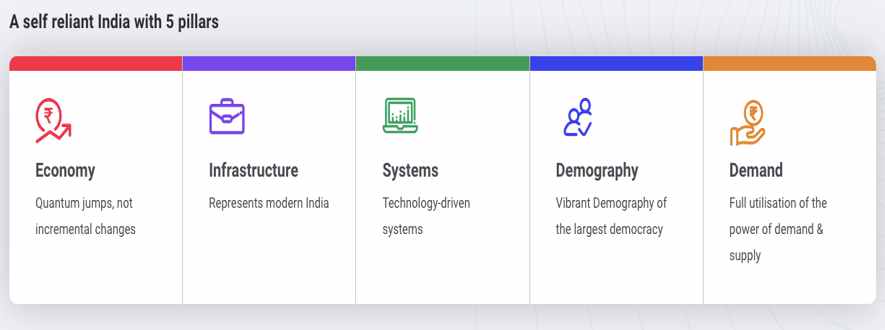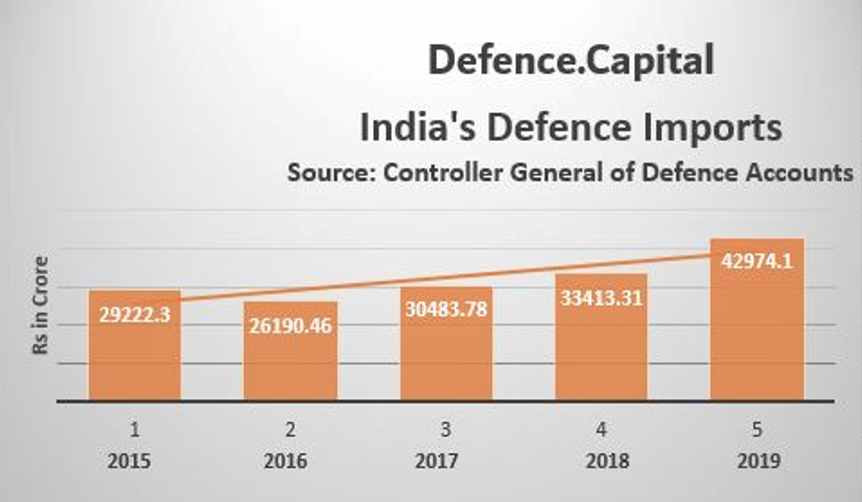- Umang Sagar
- Gov. Scheme, Recent article
Aatmnirbhar Bharat In The Defence Sector

Introduction
In the modern world of the 21st century, nations provide protection to their citizens by ensuring success, strength and sovereignty. Also, the defence sector defines the regional and global sphere of any country by providing protection to its citizens. Strong defence defines the domination of a country on the world stage. Self-sufficient in the defence sector is of crucial importance for any country to compete at the international level. The defence establishment is a major spending sector of the Indian economy, where in the 2020-21 FY (Fiscal Year) 2.1% of GDP was allocated to defence. In FY 2021-22, 13.5% of total government experience was spent in defence only. As an independent nation, India engaged in wars with Pakistan and China which, for India, projected the level of importance as a strong defence force. Today, the emerging threat of terrorism and cyber-attacks is continuously advancing. While India is progressing technologically, cyber threats like hacking, denial of service (DNS) and ransomware which could play a critical role in weakening the economy, have escalated the need for self-resilience.
According to an analysis released by Stockholm International Peace Research Institute (SIPRI), India ranks 4th among 12 Indo-pacific nations in self-reliant arms production capabilities, but the concern is, India is also ranked as the 2nd largest importer of arms for its armed forces in 2016-20.

Five Pillars Of Self-Reliant India
In May 2020, Prime minister Narendra Modi launched the Atmanirbhar Abhiyan, or self-reliance moment. The prime minister outlined five major pillars of Self-reliant India. Which are; Economy, Infrastructure, system, vibrant demography, and demand. The following are the key features of the five major pillars:
- Economy: Expand the country’s economy to US$ 5 trillion by 2025
- Infrastructure: Invest more than Rs. 10,000,000 crores (US$ 1.3 trillion) in infrastructure expansion over the next five years for achieving the US$ 5 trillion economy goal.
- Systems: Implement systems based on 21st-century technologies
- Vibrant Demography: Enhance India’s competitive edge for self-reliance over the next five years
- Demand: Utilise full resources and capacity
History Of Defence Imports
India is one of the largest importers of arms in the world. Enhancing the defence technology and achieving customisation and uniqueness is important for India to develop a surprise element over its nemesis. For encouraging industries and start-ups, The Defence Minister of India, Mr Rajnath Singh, stated that research and development are crucial to achieving self-reliance in the defence sector. Researchers claim that self-reliance in the defence sector is the most important constituent of Aatmanirbharta. Domestic weapon production has economic, technological and philosophical linkages.
India’s first prime minister, Pandit Jawaharlal Nehru, strongly believed in self-reliance or Atmanirbharta. For the economic upliftment of the country, he continuously motivated and educated the citizens of the nation. According to Pandit Nehru, scientific temper was the future of India.
12 ordinance factories were developed during British rule but there was no self-reliance and technological advancement. After the Independence, the situation remained the same due to the lack of technological advancements in available industries. Also, World war II significantly increased the demand for the armed forces of India. During the 1950s, India began to expand its defence industrial base and indigenously produced defence equipment, but advanced equipment was still imported from foreign countries. In 1956, the Industrial Policy Resolution limited the arms and ammunition industry to the public sector. Later in 1958, ordinance factories set up by the British, became core industries of the Indian defence sector. The Defence Research Development Organisation (DRDO) was established in the same year. India’s defence sector gained its first thrust after the 1962 Sino-India war in which India had to fight against the sovereignty crisis. This crisis forced the Indian government to increase its defence expenditure. The defence expenditure was then increased from 1.5% to 2.3% of GDP.

After the 1965 Indo-Pak war, India strengthened its defence ties with Russia and started license-based manufacturing. This did not involve any Indian technology as foreign technology was only being produced again. For example; the Mig-21 fighter aircraft is a Russian aircraft which manufactured in Bangalore with Hindustan Aeronautics Limited (HAL). This arrangement lessened the development, research and production in domestic industries. Post-1980s India pushed her domestic defence industry by fetching new efforts. Huge investments were made in DRDO and indigenous missile systems like Prithvi, Akash, Nag and LCA were developed. During this period India began to develop her flagship aeronautical project of Light Combat Aircraft.
In 1998, India signed an agreement with Russia in which was about developing a supersonic cruise missile called BRAHMOS. This was a joint venture between India and Russia. One more development in 1990 took place when the era of liberalisation began in India which led to the formation of several economic reforms. This liberalisation had the potential to affect the defence sector. After the reforms, at the beginning of the 21st century, India abandoned state-run enterprises and a centrally planned economy which unlocked doors for the private sector to enter the defence industry. The private sector was granted complete access to the defence industry. With liberalisation, the private sector was allowed in defence.
In 2006, the defence procurement policy ‘MAKE’ category was introduced. The MAKE category focused on Indigenous research, design, development and production. Up to 26% of FDI was allowed in the defence sector. But for advanced weaponry, India was not yet self-reliant since weapons were still being imported. For example, Sukhoi-30 MKI was commissioned in the Indian Air Force. Submarines and missile destroyers were purchased for the Navy. Howitzers Long Range Guns were purchased for the army.
Another important policy, the defence procurement policy of 2013 gave a boost to defence production. An attempt was made to boost domestic procurement in the policy. Indigenous Defence Equipment has been announced as the preferred choice. After this, India is continuously moving towards its objective of self-reliance. Today India is among those few nations that have developed Inter-continental ballistic missiles, aircraft carriers and nuclear submarines on its own. Still, India did not stop taking support from technologically advanced nations.
Defence Procurement Policy 2016
- Until 2014, the only problem in the private sector was the focus on research and development funding. Following policy measures were taken in the Defence Procurement Policy of 2016:
- Increased procurement efficiency
- Focused on ease of doing business
- Entry barriers were also worked out which would have made the entry of the private sector easier.
- The MAKE IN INDIA was also promoted during the defence procurement policy in 2016. In this Policy, a Buy (Indian-IDDM) procurement category has been introduced. IDDM is an acronym for Indigenously Designed, Developed, and Manufactured. This category was on top priority.
Steps Taken By Indian Government To Make The Defence Sector Self-sufficient
In May 2020, during the pandemic, Prime Minister Narendra Modi initiated a new campaign called Atmanirbhar Bharat Abhiyan. Under this campaign, the defence sector was declared an important sector. By making this sector self-reliant, employment opportunities can be created, and the import burden can also be reduced. During 2015-2019, India imported about 10% of the world’s arms, which was the highest in the world.
To ensure the success of the Make in India project, the Ministry of Defence took several steps. In February 2021, the Indian Army ordered M4 armoured vehicles from Bharat Forge based in Pune. 74% of FDI was allowed in the defence sector. From 2021-22, 60% of Total Capital Acquisition is reserved for Domestic Capital Procurement. 60% of procurement would be done from Indian industries only. By revising the Defence procurement procedure 2016, the ministry released Defence Acquisition 2020. The defence acquisition 2020 pushed for self-reliance, start-ups and MSME innovation.
During 2020-21, the Department of Military Affairs, and the Ministry of Defence released an important embargo list. This list banned a total of 209 import items, which would provide a push to indigenisation. Today, India has successfully developed an Industrial base which would prove helpful in making India self-reliant. DRDO plays an important role in this industrial base. DRDO is a premier research organisation in the defence sector. DRDO and 7 government companies formed out of 41 ordinance factories will form the industrial base for the defence sector. Apart from this, the government merged 41 ordinance factories and converted them into 7 government companies. Prime Minister has described these companies as the base of India’s military strength.
These 7 companies are:
- Munitions India ltd. ,
- Armoured vehicle’s Nigam ltd. ,
- Yantra India ltd. , Liders India ltd. ,
- Troop comforts ltd. , India optel ltd. ,
- Advanced Weapons and Equipment India ltd.
Also, 12 Defence PSUs (DPSUs) are contributing to India’s defence industry.
The private sector is being aggressively promoted in the defence sector. Let us understand the role of private enterprises in defence sector in brief;
As we discussed above that after 2001, India’s defence sector was opened to the private sector. The involvement of the private sector has started in big defence projects. Tata and L&T were involved in the battlefield management system. L&T will design UAV Lakshya for DRDO. DRDO has been allowed to transfer to the private sector. Also, a significant provision of strategic partnership policy was also introduced. Indian strategic policy partnership selected Indian private companies could partner with foreign companies. In which, Fighter jets, Submarines, helicopters and armoured vehicles were promoted.
Defence indigenisation is a process of developing and manufacturing defence equipment within a country as a way to reduce import dependency as well as achieve self-reliance. In august 2020, an indigenisation portal called Srijan was launched. Through Srijan portal, DPSUs and ordinance factories provide development support to the MSMEs and startups. A positive indigenisation list was created later, which would include the list of the products which would be made in India. In the race for newly made privatisation, the Kalyani Rafael advanced systems handed over its first made indigenisation missile to the Indian army in 2021. This company is a joint venture of the Kalyani Group and Rafael advanced defence systems of Israel.
There are more than 300 private companies registered in India among which 110 companies have started production for the defence sector. Many private players like Tata, Reliance, Mahindra, Adani, Kalyani Rafael advanced systems, L&T etc have entered the defence sector.
How India Can Become Self-Reliant In Defence Sector
Let us discuss some reforms which would prove effective in making India self-reliant.
The first challenge is Defence Modernisation and Growth stuck between capabilities. Where high-tech weapons are still challenging to build. This delay in growth is due to a decrease in budget allocation on long-term investments and Research and Developmental projects. The second reason is Budgetary Issues. Here, 54% of a share is given to salaries and pensions and only 27% of the share is given to Defence Modernisation. Experts say that this budget allocation should be escalated. Also, strategic planning of the needs of armed forces like high-tech weapons and equipment should be done and must be included in long-term planning.
The Decision-making process should be made more efficient and streamlining Bureaucratic red-tapism is important. The Private sector can certainly prove to be helpful in realising India’s dream of self-reliance. The private sector will also have to engage in handling big defence projects. Private players can also be given the responsibility of repairing and maintenance of machinery.
This campaign to make the country self-dependent is commendable. A robust domestic defence manufacturing sector can take India’s military capabilities to new heights and make the dream of self-dependence come true.
Top 13 Facts About Aatmnirbhar Bharat
Self-reliance is an individual’s, a household’s, or a community’s social and economic ability to meet basic needs such as protection, food, water, shelter, personal safety health, and education in a dignified manner.
India can only become self-sufficient if it takes advantage of its best endowment.
India is in a unique position at a time all other manufacturing behemoth- Japan, the EU, the US, and even South Korea and China- are again in lockstep.
Most of these countries have exited low0end labor-incentive manufacturing, and countries such as Bangladesh, Vietnam, Mexico, and others have taken their place.
State-funded R&D, including basic research by PSUs research institutions and universities, must be significantly increased, far exceeding the current paltry 1% of GDP.
India’s meagre public expenditure on education must be significantly increased as opposed to current privatization trends, which would only reduce access including in skill development.
Without widespread access to high-quality public education, no country has achieved self-sufficiency.
The goal of Aatmanirbhar Bharat is to make the country and its people self-sufficient in all aspects.
Atmanirbhar Bharat is built on five pillars: Economy, Infrastructure, System, Vibrant demography and demand.
The finance minister announced government reforms and enablers in seven sectors as part of the Aatmanirbhar Bharat Abhiyan.
The government implemented several bold reforms, including agricultural supply chain reforms, rational tax systems, simple and clear laws, capable human resources, and a strong financial system.
The goal of Atmanirbhar Bharat Rojgar Yojna is to increase job creation and reduce the socioeconomic impact of the covid-19 pandemic.
Under ABRY, the government of India credits both the employees’ share and employer’s share of contribution payable for a period of two years, or only the employees’ share, depending on the employment strength of the EPFO registered establishment.



